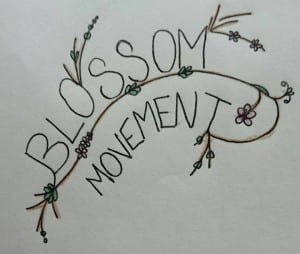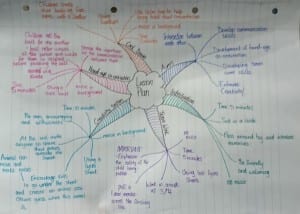Lesson Plan:
| Time | Activity | Music &Materials | Teaching Points |
| 5 minutes | Introduction | Toy, No Music | Welcoming, Friendly, Sit – same level |
| 5 minutes | Team work exercise – Race. Children working in groups of 3/4 – Pulling one member of the team across room. | 2 lycra sheets, no music. | Exaggerate the importance of safety – Support the person in the sheet of lycra. |
| 10 minutes | Creativity Session – Children volunteer to go under lycra sheet and make an animal shape – Outside people guess the animal shape – Noises and movement can be used too. | Low level music, lycra sheet. | Be encouraging and enthusiastic. |
| 5 minutes | Hand eye coordination – Sit in circle – Children pass ball to each other – Person rolling waves to the person they’re rolling to (using eye contact) – Ball roller has to wait till the other person has responded and waved back. | Low level music, Ball. | Emphasize that they’re not allowed to roll the ball to someone till the other person has responded. |
| 5 minutes | Cool down – Sat in a circle – Children have feathers – Used to stroke across their body – Feel the different sensations. | Calm music in the background, Feathers. | Calm tone to help bring the children’s focus back. |
Evaluation:
Overall our class went well and all of the activities we chose were suitable for our chosen age group (early years). However, when receiving feedback from our peers we realised several aspects of our class which would not have worked if we were actually teaching early years. Firstly, the gap between each activity was fractionally too long and it would have been hard for the children to focus in these moments. Varying the pitch of our voice more frequently would have allowed us to engage more with the children and it would help them to focus on the tasks. Also, we should have encouraged the children to be more vocal, “supporting children to become skilful communicators from an early age” (Cohen et al, 2010, 269). When splitting the children into three groups we should have put them into groups as asking them to get into groups at such a young age would have been very challenging for them. Moreover, if we were going to facilitate this class again we would have only divided them into two groups as having three groups meant that always one group was left out and at one point had nobody keeping an eye on them. We were intending to use music throughout the session however, we forgot and this meant there were times when it was too quiet. We could have also used vocalisations in the ball game section to help with the silence. At the end of the session the children were asked to pretend to be sleeping lions, when earlier in the session they got to choose an animal so we could have continued this idea and got them to be the animal they chose earlier. When working with early years a physical presence is important and to have cues in which the children know to listen to you is also an important part of controlling how the class plays out, so this could have been used in our session. The last main point raised was that we should have been frequently appraising the children in order to motivate them. Putting all this feedback into action would create a much more successful session with early years.
Cohen, L. Manion, L. Morrison, K. and Wyse, D. (2010) A Guide To Teaching Practice. Revised 5th edition. London New York: Routledge.
Risk Assessment:
| Activities | Hazards |
Risk rating Low Medium High |
Precautions to be taken | Additional information for leaders |
| Introduction/ Welcome | Make sure the toy is passed around the circle in a safe manor. |
X |
Demonstrate how to pass the toy correctly and emphasise the importance of passing ‘Ellie’ the elephant gently. | |
| Race Game | The head of the child in the lyrca not being supported during the race. |
X |
Ensure children know that if the child they are pulling is not being looked after the teacher will stop the race. | Observe the children inside the sheet for signs of distress. |
| Creativity Section | Child under sheet may injure themselves or become distressed. |
X |
Ensure children are not under the sheet for too long. | Keep an eye on the children under the sheet to ensure that they are still happy. |
| Ball game | Children may throw the ball instead of rolling it gently. |
X |
Ensure that children know that they are only rolling the ball and that throwing is not allowed. | Positive acknowledgement for the children for gently rolling the ball. |
| Cool down with feathers | Children eating/ chewing feathers or poking themselves in the eye with their feather. |
X |
Demonstrate how gently to brush the feather across their faces. Keep a close eye on students to ensure no one is chewing/ eating or misbehaving with the feathers. |

